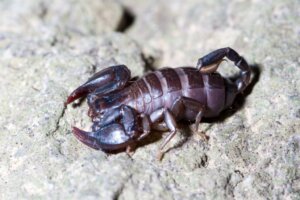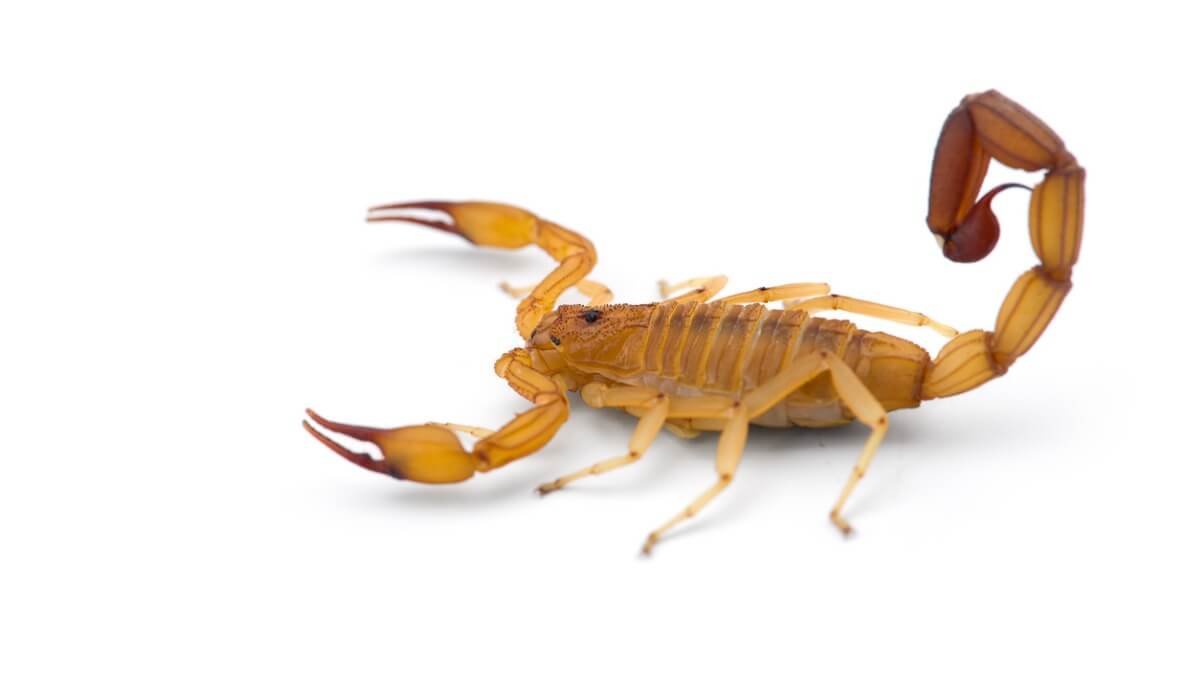How and What Do Scorpions Eat?


Written and verified by the biologist Cesar Paul Gonzalez Gonzalez
Scorpions, first appeared on Earth, according to experts, about 5 million years ago. However, they haven’t changed much since then, which seems to indicate that their characteristics were enough to survive until now. And, curiously, what they eat and the way they hunt are also part of scorpions’ survival strategy.
If you have questions about what scorpions eat (or are capable of eating), be sure to read this article.
What are scorpions?
Scorpions are arthropods that stand out for their elongated body, the presence of a tail that injects poison, and their large claws. These organisms belong to the group of arachnids, along with spiders, mites and tarantulas. However, they are one of the most problematic invertebrates for humans due to the toxins they produce.
As you can see, these arthropods are dangerous machines for prey and predators alike. For this reason, their diet can be very varied and even contain some species from the same group on the menu. The poisons they possess are a great tool when hunting prey that would seem to be beyond them.
The scorpion’s metasoma (its tail) contains a telson that ends in a stinger. This communicates directly with the venom-producing glands.

What do scorpions eat?
In general, scorpions are carnivores and specialize in insects and other invertebrates. For this reason, it’s common to see them walking through vegetation, remaining immobile waiting to catch an appetizing arthropod. In the following list, we’ve compiled some of the most common prey of this arachnid:
- Spiders
- Crickets
- Beetles
- Ants
- Wasps
- Grasshoppers
- Termites
- Lizards
- Small rodents
- Worms
- Snails
- Flies
- Bees
- Tadpoles
- Snakes
- Other scorpions
To devour their prey, scorpions can feast on them immediately, or wait until they reach a hiding place. They usually immobilize their victim with their venom and devour it starting with its head. They don’t chew their food, but use an external digestion similar to that of spiders.
Scorpions expel enzymes to liquefy their food and then sip it through their mouths. Their pedipalps and chelicerae help them to cut up the prey.
The victims that each species can hunt are very different, since they depend a lot on the size and poisonous capacity of the scorpion. In any case, all of them mainly use their pincers and their tail to hunt. While they hold the prey, the poison finishes killing it. The larger the tail of the specimen, the more dangerous experts believe it to be as regards the toxins it produces.
Patient hunters
A hunter doesn’t only use tools, but also strategies. Scorpions follow the same premise, as their victims are usually much more agile beings than they are. To do this, they use behavior of the “sit and wait” type, in which they lurk, waiting to attack their prey by surprise.
Scorpions have a very slow metabolism and can go years without eating. Therefore, they’re unable to actively run or chase their prey. Being ectotherms, they lack the capacity to produce their own heat and are 100% dependent on environmental conditions.
It’s easy to think that scorpions use their eyes to hunt, but, in reality, they’re not so good at distinguishing images. In fact, most of them only detect shadows and light intensities, and so they have to use other senses. In addition, their body also has small hairs that allow them to feel the vibrations of the air and the ground.
As if that weren’t enough, the physical adaptations that the scorpion has to hunt include a kind of “comb” in its belly, which serves as a chemoreceptor. This trait is nothing more than an extra sense that allows it to detect odors in the form of particles on the ground. The latter means that it’s able to “smell” its prey through these structures, helping it to sniff them out and track them.
Do scorpions eat each other?
The species in this group are usually competitive and aggressive, which causes them to have battles with other specimens of the same or different species. For this reason, if they have the opportunity, they will eat other scorpions. It sounds drastic, but you could say that it’s a way to use conflict to their advantage and that their fighting isn’t just a waste of energy.
In addition to this, there are some species that can be eaten at the end of their reproduction or even ones that feed on their own young. This cannibalistic behavior is nothing more than a means to optimize their resources and survive when they’re scarce.
Scorpions have a complex way of feeding, as they’re well prepared to face their environment. Despite being very dangerous beings (and capable of even causing death) they’re still a fundamental part of the ecosystem. Predators like them are regulators of the environmental balance, and not a threat that must be eradicated.
Scorpions, first appeared on Earth, according to experts, about 5 million years ago. However, they haven’t changed much since then, which seems to indicate that their characteristics were enough to survive until now. And, curiously, what they eat and the way they hunt are also part of scorpions’ survival strategy.
If you have questions about what scorpions eat (or are capable of eating), be sure to read this article.
What are scorpions?
Scorpions are arthropods that stand out for their elongated body, the presence of a tail that injects poison, and their large claws. These organisms belong to the group of arachnids, along with spiders, mites and tarantulas. However, they are one of the most problematic invertebrates for humans due to the toxins they produce.
As you can see, these arthropods are dangerous machines for prey and predators alike. For this reason, their diet can be very varied and even contain some species from the same group on the menu. The poisons they possess are a great tool when hunting prey that would seem to be beyond them.
The scorpion’s metasoma (its tail) contains a telson that ends in a stinger. This communicates directly with the venom-producing glands.

What do scorpions eat?
In general, scorpions are carnivores and specialize in insects and other invertebrates. For this reason, it’s common to see them walking through vegetation, remaining immobile waiting to catch an appetizing arthropod. In the following list, we’ve compiled some of the most common prey of this arachnid:
- Spiders
- Crickets
- Beetles
- Ants
- Wasps
- Grasshoppers
- Termites
- Lizards
- Small rodents
- Worms
- Snails
- Flies
- Bees
- Tadpoles
- Snakes
- Other scorpions
To devour their prey, scorpions can feast on them immediately, or wait until they reach a hiding place. They usually immobilize their victim with their venom and devour it starting with its head. They don’t chew their food, but use an external digestion similar to that of spiders.
Scorpions expel enzymes to liquefy their food and then sip it through their mouths. Their pedipalps and chelicerae help them to cut up the prey.
The victims that each species can hunt are very different, since they depend a lot on the size and poisonous capacity of the scorpion. In any case, all of them mainly use their pincers and their tail to hunt. While they hold the prey, the poison finishes killing it. The larger the tail of the specimen, the more dangerous experts believe it to be as regards the toxins it produces.
Patient hunters
A hunter doesn’t only use tools, but also strategies. Scorpions follow the same premise, as their victims are usually much more agile beings than they are. To do this, they use behavior of the “sit and wait” type, in which they lurk, waiting to attack their prey by surprise.
Scorpions have a very slow metabolism and can go years without eating. Therefore, they’re unable to actively run or chase their prey. Being ectotherms, they lack the capacity to produce their own heat and are 100% dependent on environmental conditions.
It’s easy to think that scorpions use their eyes to hunt, but, in reality, they’re not so good at distinguishing images. In fact, most of them only detect shadows and light intensities, and so they have to use other senses. In addition, their body also has small hairs that allow them to feel the vibrations of the air and the ground.
As if that weren’t enough, the physical adaptations that the scorpion has to hunt include a kind of “comb” in its belly, which serves as a chemoreceptor. This trait is nothing more than an extra sense that allows it to detect odors in the form of particles on the ground. The latter means that it’s able to “smell” its prey through these structures, helping it to sniff them out and track them.
Do scorpions eat each other?
The species in this group are usually competitive and aggressive, which causes them to have battles with other specimens of the same or different species. For this reason, if they have the opportunity, they will eat other scorpions. It sounds drastic, but you could say that it’s a way to use conflict to their advantage and that their fighting isn’t just a waste of energy.
In addition to this, there are some species that can be eaten at the end of their reproduction or even ones that feed on their own young. This cannibalistic behavior is nothing more than a means to optimize their resources and survive when they’re scarce.
Scorpions have a complex way of feeding, as they’re well prepared to face their environment. Despite being very dangerous beings (and capable of even causing death) they’re still a fundamental part of the ecosystem. Predators like them are regulators of the environmental balance, and not a threat that must be eradicated.
All cited sources were thoroughly reviewed by our team to ensure their quality, reliability, currency, and validity. The bibliography of this article was considered reliable and of academic or scientific accuracy.
- Polis, G. A. (1979). Prey and feeding phenology of the desert sand scorpion Pamroctonus mesaensis (Scorpionidae: Vaejovidae). Journal of Zoology, 188(3), 333-346.
- Polis, G. A., & Farley, R. D. (1979). Behavior and ecology of mating in the cannibalistic scorpion, Paruroctonus mesaensis Stahnke (Scorpionida: Vaejovidae). Journal of Arachnology, 33-46.
- PERETTI, A. V., ACOSTA, L. E., & BENTON, T. G. (1999). Sexual cannibalism in scorpions: fact or fiction?. Biological Journal of the Linnean Society, 68(4), 485-496.
- Tirgari, S., & Zargan, J. (2002). Scorpions in urban areas in Iran and recent progress of laboratory research (Scorpionida: Scorpionidae, Buthidae). In the Proceeding of the 4th International Conference on Urban Pests (pp. 7-10).
- Wendruff, A. J., Babcock, L. E., Wirkner, C. S., Kluessendorf, J., & Mikulic, D. G. (2020). A Silurian ancestral scorpion with fossilised internal anatomy illustrating a pathway to arachnid terrestrialisation. Scientific reports, 10(1), 1-6.
- Chakravarthy, A. K., & Sridhara, S. (Eds.). (2016). Arthropod Diversity and Conservation in the Tropics and Sub-tropics. Springer.
This text is provided for informational purposes only and does not replace consultation with a professional. If in doubt, consult your specialist.








